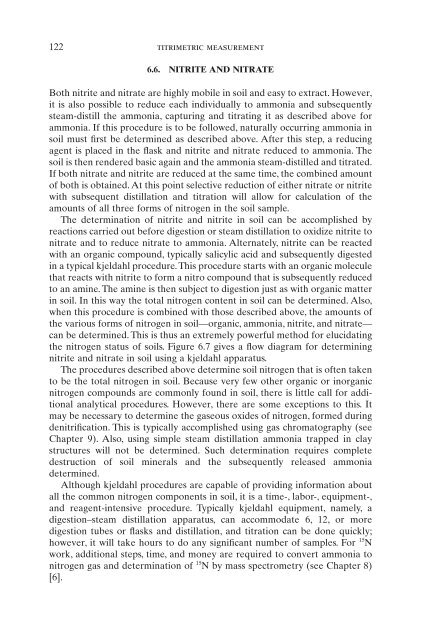Introduction to Soil Chemistry
Introduction to Soil Chemistry
Introduction to Soil Chemistry
You also want an ePaper? Increase the reach of your titles
YUMPU automatically turns print PDFs into web optimized ePapers that Google loves.
122 titrimetric measurement<br />
6.6. NITRITE AND NITRATE<br />
Both nitrite and nitrate are highly mobile in soil and easy <strong>to</strong> extract. However,<br />
it is also possible <strong>to</strong> reduce each individually <strong>to</strong> ammonia and subsequently<br />
steam-distill the ammonia, capturing and titrating it as described above for<br />
ammonia. If this procedure is <strong>to</strong> be followed, naturally occurring ammonia in<br />
soil must first be determined as described above. After this step, a reducing<br />
agent is placed in the flask and nitrite and nitrate reduced <strong>to</strong> ammonia. The<br />
soil is then rendered basic again and the ammonia steam-distilled and titrated.<br />
If both nitrate and nitrite are reduced at the same time, the combined amount<br />
of both is obtained. At this point selective reduction of either nitrate or nitrite<br />
with subsequent distillation and titration will allow for calculation of the<br />
amounts of all three forms of nitrogen in the soil sample.<br />
The determination of nitrite and nitrite in soil can be accomplished by<br />
reactions carried out before digestion or steam distillation <strong>to</strong> oxidize nitrite <strong>to</strong><br />
nitrate and <strong>to</strong> reduce nitrate <strong>to</strong> ammonia. Alternately, nitrite can be reacted<br />
with an organic compound, typically salicylic acid and subsequently digested<br />
in a typical kjeldahl procedure. This procedure starts with an organic molecule<br />
that reacts with nitrite <strong>to</strong> form a nitro compound that is subsequently reduced<br />
<strong>to</strong> an amine. The amine is then subject <strong>to</strong> digestion just as with organic matter<br />
in soil. In this way the <strong>to</strong>tal nitrogen content in soil can be determined. Also,<br />
when this procedure is combined with those described above, the amounts of<br />
the various forms of nitrogen in soil—organic, ammonia, nitrite, and nitrate—<br />
can be determined. This is thus an extremely powerful method for elucidating<br />
the nitrogen status of soils. Figure 6.7 gives a flow diagram for determining<br />
nitrite and nitrate in soil using a kjeldahl apparatus.<br />
The procedures described above determine soil nitrogen that is often taken<br />
<strong>to</strong> be the <strong>to</strong>tal nitrogen in soil. Because very few other organic or inorganic<br />
nitrogen compounds are commonly found in soil, there is little call for additional<br />
analytical procedures. However, there are some exceptions <strong>to</strong> this. It<br />
may be necessary <strong>to</strong> determine the gaseous oxides of nitrogen, formed during<br />
denitrification. This is typically accomplished using gas chroma<strong>to</strong>graphy (see<br />
Chapter 9). Also, using simple steam distillation ammonia trapped in clay<br />
structures will not be determined. Such determination requires complete<br />
destruction of soil minerals and the subsequently released ammonia<br />
determined.<br />
Although kjeldahl procedures are capable of providing information about<br />
all the common nitrogen components in soil, it is a time-, labor-, equipment-,<br />
and reagent-intensive procedure. Typically kjeldahl equipment, namely, a<br />
digestion–steam distillation apparatus, can accommodate 6, 12, or more<br />
digestion tubes or flasks and distillation, and titration can be done quickly;<br />
however, it will take hours <strong>to</strong> do any significant number of samples. For 15 N<br />
work, additional steps, time, and money are required <strong>to</strong> convert ammonia <strong>to</strong><br />
nitrogen gas and determination of 15 N by mass spectrometry (see Chapter 8)<br />
[6].
















